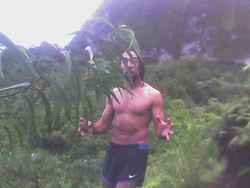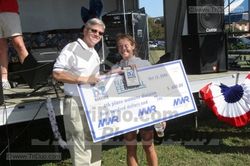. It's an excellent tale about McDougall's foray into the secret world of the Tarahumara Indians, arguably the greatest runners on earth, who live in the treacherous terrain of Mexico's Copper Canyons. Along the way, he encounters ultrarunners of all sorts, including and . He rounds all these folks up to head off to Tarahumara land for a hush-hush race through the Canyons set up by , a mysterious American loner who's gone native. This book will not only make you want to run; it will make you want to to reconnect with an ancient way of life.
If you think you don't have it in you to be a runner, don't despair. It's in there somewhere. You may never run like the Tarahumara, but you can at least gear up for a marathon. Check out to get you off the couch and out the door.
–Aileen Torres

I sure have. We've all stayed in touch and tend to weave in and out of each other's lives. Billy [Barnett] is living out of a car in Hawaii. We went for a killer four-hour run on the Pali Trail when I was there last year (see photo of Billy Bonehead, Hawaiian-style). Billy, Jenn, , and I all crewed for Luis [Escobar] at Badwater and were at the finish for Scott Jurek's second Badwater win. Most recently, I got a call from Caballo when I was about to speak at a bookstore in L.A. He'd driven up from Mexico in his latest ancient pickup to be there but broke down on the edge of town. It was surreal–we got him a lift, and an hour later I was telling an audience: “And then I went in search of the mysterious White Horse…who's drinking a beer in the corner.” Caballo is putting the race on again this year, and, fingers crossed, it should be sensational.
You're running regularly after training with . Are you relatively injury-free? What's the best advice he gave you?
The last time I got an injury was the last time I wore running shoes. After the race, I made the mistake of thinking I was now a 21st century Tarahumara and had such perfect technique that I could run any distance in any shoes. A nasty case of plantar fasciitis cleared up that delusion. I'd started running in a thick pair of Nikes because we'd gotten a lot of snow, and my running form went to hell. Once I shucked the shoes and tightened up my technique, I got better fast and haven't had a twinge since. The best advice I got from Eric should be on a bumper sticker on every car in America: “If it feels like work, you're working too hard.” It's a Jackson Hole variation of Lydiard's “Train, don't strain” and applies to everything.
What's your daily/weekly running routine?
I'm now a Jenn Shelton disciple. I take off whenever I can't stand being inside anymore and go as far and as fast as I feel like. Usually, that's somewhere in the two-hour range. I'm surrounded by hilly country roads and farm lanes, so I pick whatever direction looks nicest that day and just go.
What's the best running form to prevent injury, and how can you stay conscious of it while running?
I think 's study last month in magazine pretty much ended the debate once and for all. He found that runners with a mid- or fore-foot strike have almost zero impact, while heel strikers come down with three times their body weight. In terms of technique that translates to simple advice: Run exactly as you would if you were barefoot. I try to go barefoot all the time for that reason. And when I do have to wear a minimal shoe, I focus on getting my foot off the ground as quickly as possible. You're not going to run into a lot of problems if you're in the air more than you're on the ground.
You've run a 50-mile race in the middle of scorching heat and rocky terrain in the Copper Canyons. How did you stay motivated?
That race was a total blast. Well, all except the last few miles when I ran out of water and was confronted by Barefoot Ted and a bottle of urine. Motivation wasn't a problem at all, mostly because I'd trained right and was focused on racing the course, not the other runners.
Done any more ultrarunning? What's your next race?
Nearly all my running these days, ultra or otherwise, has been spontaneous and strictly for fun. I was under the gun pretty fiercely the last couple of years while working on this book, so I didn't want to add any more deadlines by signing up for races. Billy Bonehead taught me when we ran together in Hawaii that if you wake up and feel like running 40 miles, why wait three months until 500 strangers can join you? Just grab a buddy and a water bottle and go.

The two hardest pieces of advice for any marathoner to take: No. 1, focus on form first. Everyone wants to ramp up their mileage fast and start hitting those 20-mile Sunday runs, but it's way more important to make absolutely sure that you've got your foot strike and running form dialed in first. You'll be glad you did when you're three months into training and your legs still feel great. And No. 2, enjoy it. Who really gives a crap if you finish in four hours or 3:59.59? Unless there's a chance someone will be waiting for you with a poster-sized check at the finish line, you might as well forget about racing and have a good time. No one hoots and hollers and high-fives more during a race than Jenn Shelton (see photo), but she still manages to go pretty fast.
What running shoes do you recommend?
I don't. I recommend running technique, not running shoes. If you've got to strap something on, wear it for protection, not correction. Anything that alters the way your foot naturally moves is going to cause problems.
What are the benefits of barefoot running for you?
I'm like a recovering alcoholic: Once I start monkeying around with shoes, I get sloppy and into trouble. That's why I go barefoot nearly all the time these days. It keeps my running form honest.
There are many reasons for running. What's yours?
Same reason I liked it when I was five. You can just bust out the door and take off.